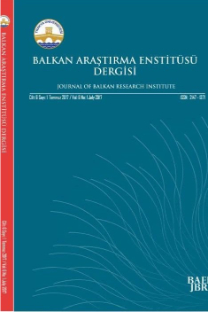REUNIFICATION OF MOSTAR: “IS THERE A HOPE?”
20. yüzyılın son on yılında, Yugoslavya'nın dağılma süreciyle birlikte, Federasyon'u oluşturan devletler etnik gruplar arası çatışmalara sahne oldu. Ancak, en şiddetli çatışmalar Bosna Hersek'te meydana geldi . Bu çalışma spesifik olarak Mostar'daki Boşnak-Hırvat çatışmasını ele almayı amaçlamaktadır. Mostar, güney Bosna Hersek'te Neretva nehri üzerinde bulunmaktadır ve nüfus yapısı açısından kendine has bir karakteristiğe sahiptir. Hersek bölgesindeki çatışmalar süresince Mostar şehri önce Sırplar sonra Hırvatlar tarafından kuşatılmıştır. Etnik gruplar arasındaki bu çatışmaların ardından şehir iki parçaya bölünmüştür. Bugün, şehrin batı bölümü ağırlıklı olarak Hırvat iken, Mostar'ın doğu bölümü ağırlıklı olarak Boşnak'tır. Bu bağlamda, çalışma temel olarak; öncelikle şimdiye kadar uygulanan yeniden birleştirme çalışmaları, ikinci olarak da Mostar'daki mevcut durum üzerinde durmayı hedeflemektedir
MOSTAR’IN YENİDEN BİRLEŞMESİ: “BİR UMUT VAR MI?”
In the last decade of 20th century, along with the dissolution process of Yugoslavia, constituent states of Federation have witnessed inter-ethnic conflicts. However, the most violent clashes took place in Bosnia and Herzegovina (19921995). This study intends to discuss the Bosniak-Croat conflict in Mostar in a specific way. Mostar -is located on the Neretva River in shoutern Bosnia and Herzegovina and -has a peculiar characteristic in terms of its population structure. During the conflicts in Herzegovina region, the city of Mostar was besieged firstly by Serbs then Croats. In the wake of these inter-ethnic conflicts, the city was divided into two parts. Today, the eastern side of Mostar is predominantly Bosniac, while the western side of the city is predominantly Croat. In this context, this study basically aims to dwell on; firstly reunification attempts that have been implemented by the international communities so far, and secondly the present situation in Mostar
___
- BIEBER, Florian, “Local Institutional Engineering: A Tale of Two Cities, Mostar and Brcko”, International Peacekeeping, Vol. 12, No. 3, 2005, pp. 420-433.
- BOLLENS, Scott A., “Comparative Research on Contested Cities: Lenses and Scaffoldings”, Crisis States Working Papers Series No.2, Crisis States Research Centre, London 2007.
- ________, Cities, Nationalism and Democratization, Routledge, 2007.
- BOSE, Sumantra, Bosnia After Dayton: Nationalist Partition and International Intervention, Hurst and Co., London 2002.
- CALAME, Jon and Pasic, Amir, “Post-conflict Reconstruction in Mostar: Cart Before the Horse”, Divided Cities/Contested States Working Paper, No. 7, 2009, pp. 3-20.
- ICG Balkans Report, Reunifiying Mostar: Opportunities for Progress, No:90, Sarajevo/Washington/Brussels,2000.
- ICG Euro Report, Building Bridges in Mostar, No:150, Sarajevo/Brussels 2003.
- MAKAŠ, Emily Gunzburger, “Mostar’s Central Zone: Battles over Shared Space in a Divided City”, Urban Conflicts: Ethno-Nationalist Divisions, States and Cities Conference, Queen’s University, Belfast 2011.
- MOSER, Caroline and McIlwaine, Cathy, Encounters with Violence in Latin America: Urban Poor Perceptions from Columbia and Guatemala, Routledge, London 2004.
- Office of the High Representative (OHR), Commission for Reforming the City of Mostar, Mostar 2003.
- Official Journal of the European Communities, C 287, Vol. 39, 1996.
- OGNYANOVA, Irina, “Nationalism and National Policy in Independent State of Croatia (1941-1945)”, IWM Junior Visiting Fellows Conferences, Vol. 6, Vienna 2000.
- PALMBERGER, Monika, “Renaming of Public Space: A Policy of Exclusion in Bosnia and Herzegovina”, MMG Working Paper 12-02, 2012, pp. 3-26.
- The World Bank Implementation Completion Report, Report No: 32713, 2005.
- UNESCO, “Stari Most: Rebuilding More Than a Historic Bridge in Mostar”, Museum International (Quarterly Published Journal), No.224, Blackwell Publishing, 2004.
- YARWOOD, John, Rebuilding Mostar: Reconstruction in a War Zone, Liverpool University Press, Liverpool 1999.
- ISSN: 2147-1371
- Yayın Aralığı: 2
- Başlangıç: 2012
- Yayıncı: TRAKYA ÜNİVERSİTESİ BALKAN ARAŞTIRMA ENSTİTÜSÜ
